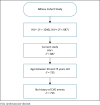Comparative performance of cardiovascular risk prediction models in people living with HIV
- PMID: 36479421
- PMCID: PMC9724117
- DOI: 10.4102/sajhivmed.v23i1.1395
Comparative performance of cardiovascular risk prediction models in people living with HIV
Abstract
Background: Current cardiovascular risk assessment in people living with HIV is based on general risk assessment tools; however, whether these tools can be applied in sub-Saharan African populations has been questioned.
Objectives: The study aimed to assess cardiovascular risk classification of common cardiovascular disease (CVD) risk prediction models compared to the Data Collection on Adverse Events of Anti-HIV Drugs (D:A:D) 2010 and 2016 models in people living with HIV.
Method: Cardiovascular disease risk was estimated by Framingham Cardiovascular and Heart Disease (FHS-CVD, FHS-CHD), Atherosclerotic Cardiovascular Disease (ASCVD) and D:A:D 2010 and 2016 risk prediction models for HIV-infected participants of the Ndlovu Cohort Study, Limpopo, rural South Africa. Participants were classified to be at low (< 10%), moderate (10% - 20%), or high-risk (> 20%) of CVD within 10 years for general CVD and five years for D:A:D models. Kappa statistics were used to determine agreement between CVD risk prediction models. Subgroup analysis was performed according to age.
Results: The analysis comprised 735 HIV-infected individuals, predominantly women (56.7%), average age 43.9 (8.8) years. The median predicted CVD risk for D:A:D 2010 and FHS-CVD was 4% and for ASCVD and FHS-CHD models, 3%. For the D:A:D 2016 risk prediction model, the figure was 5%. High 10-year CVD risk was predicted for 2.9%, 0.5%, 0.7%, 3.1% and 6.6% of the study participants by FHS-CVD, FHS-CHD, ASCVD, and D:A:D 2010 and 2016. Kappa statistics ranged from 0.34 for ASCVD to 0.60 for FHS-CVD as compared to the D:A:D 2010 risk prediction model.
Conclusion: Overall, predicted CVD risk is low in this population. Compared to D:A:D 2010, CVD risk estimated by the FHS-CVD model showed similar overall results for risk classification. With the exception of the D:A:D model, all other risk prediction models classified fewer people to be at high estimated CVD risk. Prospective studies are needed to develop and validate CVD risk algorithms in people living with HIV in sub-Saharan Africa.
Keywords: Atherosclerotic Cardiovascular Disease Risk Score; D:A:D risk score; Framingham risk score; cardiovascular disease risk; people living with HIV; sub-Saharan Africa.
© 2022. The Authors.
Conflict of interest statement
The authors declare that they have no financial or personal relationships that may have inappropriately influenced them in writing this article.
Figures




Similar articles
-
Cardiovascular risk prediction in HIV-infected patients: comparing the Framingham, atherosclerotic cardiovascular disease risk score (ASCVD), Systematic Coronary Risk Evaluation for the Netherlands (SCORE-NL) and Data Collection on Adverse Events of Anti-HIV Drugs (D:A:D) risk prediction models.HIV Med. 2016 Apr;17(4):289-97. doi: 10.1111/hiv.12300. Epub 2015 Aug 12. HIV Med. 2016. PMID: 26268806
-
Cardiovascular Risk Prediction Functions Underestimate Risk in HIV Infection.Circulation. 2018 May 22;137(21):2203-2214. doi: 10.1161/CIRCULATIONAHA.117.028975. Epub 2018 Feb 14. Circulation. 2018. PMID: 29444987 Free PMC article.
-
Cardiovascular disease risk prediction by the American College of Cardiology (ACC)/American Heart Association (AHA) Atherosclerotic Cardiovascular Disease (ASCVD) risk score among HIV-infected patients in sub-Saharan Africa.PLoS One. 2017 Feb 24;12(2):e0172897. doi: 10.1371/journal.pone.0172897. eCollection 2017. PLoS One. 2017. PMID: 28235058 Free PMC article.
-
Prediction models for cardiovascular disease risk among people living with HIV: A systematic review and meta-analysis.Front Cardiovasc Med. 2023 Mar 23;10:1138234. doi: 10.3389/fcvm.2023.1138234. eCollection 2023. Front Cardiovasc Med. 2023. PMID: 37034346 Free PMC article. Review.
-
Assessing Cardiovascular Risk in People Living with HIV: Current Tools and Limitations.Curr HIV/AIDS Rep. 2021 Aug;18(4):271-279. doi: 10.1007/s11904-021-00567-w. Epub 2021 Jul 11. Curr HIV/AIDS Rep. 2021. PMID: 34247329 Free PMC article. Review.
References
-
- Global HIV and AIDS statistics | Avert [homepage on the Internet]. [cited 2021 May 25]. Available from: https://www.avert.org/global-hiv-and-aids-statistics
-
- Massyn N, Day C, Ndlovu N, Padayachee T. District health barometer 2019/2020 [homepage on the Internet]. 2020. [cited 2021 May 25]. Available from: https://www.hst.org.za/publications/Pages/DHB2019-20.aspx
Grants and funding
LinkOut - more resources
Full Text Sources
